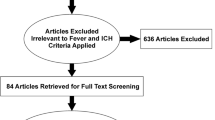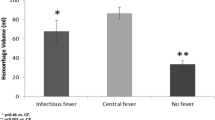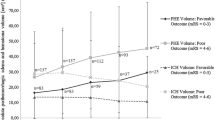Abstract
Background
Fever and hematoma growth are known to be independent predictors of poor outcome after intracerebral hemorrhage (ICH). We sought to assess the distribution of temperature at different stages in relation to hematoma growth and functional outcome at 90 days in a cohort of ICH patients.
Methods
Data of patients registered in the Virtual International Stroke Trials Archive—ICH were analyzed. Temperatures at baseline, 24, 48, 72, and 168 h were assessed in relation to the hematoma growth and functional outcome at 90 days. We calculated the daily linear variation of each subject’s temperature by subtracting 37 °C from the maximal daily recorded temperature (delta-temperature). We used logistic regression and mixed-effects models to identify factors associated with hematoma growth, poor outcome, and temperature elevation after ICH.
Results
303 patients were included in the analysis. The average age was 66 ± 12 years, 200 (66 %) were males, median admission NIHSS was 13 [Interquartile range (IQR), 9–18), median GCS was 15 (IQR, 14–15). Hematoma growth occurred in 22 % and poor functional outcome at 90-days occurred in 41 % of the patients. Cumulative delta-temperature at 72 h was associated with hematoma growth; age, ICH score, hematoma growth, and cumulative delta-temperature at 168 h were associated with poor outcome at 90 days. Factors associated with fever in mixed-models were day after onset of ICH, hypertension, base hematoma volume, intraventricular-hemorrhage, pneumonia, and hematoma growth.
Conclusions
There is a temporal and independent association between fever and hematoma growth. Fever after ICH is associated with poor outcome at 90 days. Future research is needed to study the mechanisms of this phenomenon and if early protocols of temperature modulation would be associated with improved outcomes after ICH.

Similar content being viewed by others
References
Brott T, Broderick J, Kothari R, et al. Early hemorrhage growth in patients with intracerebral hemorrhage. Stroke. 1997;28:1–5.
Gebel JM Jr, Jauch EC, Brott TG, et al. Relative edema volume is a predictor of outcome in patients with hyperacute spontaneous intracerebral hemorrhage. Stroke. 2002;33:2636–41.
Fujii Y, Takeuchi S, Sasaki O, Minakawa T, Tanaka R. Multivariate analysis of predictors of hematoma enlargement in spontaneous intracerebral hemorrhage. Stroke. 1998;29:1160–6.
Fujii Y, Tanaka R, Takeuchi S, Koike T, Minakawa T, Sasaki O. Hematoma enlargement in spontaneous intracerebral hemorrhage. J Neurosurg. 1994;80:51–7.
Kazui S, Naritomi H, Yamamoto H, Sawada T, Yamaguchi T. Enlargement of spontaneous intracerebral hemorrhage. Incidence and time course. Stroke. 1996;27:1783–7.
Wada R, Aviv RI, Fox AJ, et al. CT angiography “spot sign” predicts hematoma expansion in acute intracerebral hemorrhage. Stroke. 2007;38:1257–62.
Mayer SA. Ultra-early hemostatic therapy for intracerebral hemorrhage. Stroke. 2003;34:224–9.
Mayer SA, Lignelli A, Fink ME, et al. Perilesional blood flow and edema formation in acute intracerebral hemorrhage: a SPECT study. Stroke. 1998;29:1791–8.
Becker KJ, Baxter AB, Bybee HM, Tirschwell DL, Abouelsaad T, Cohen WA. Extravasation of radiographic contrast is an independent predictor of death in primary intracerebral hemorrhage. Stroke. 1999;30:2025–32.
Qureshi AI, Ali Z, Suri MF, et al. Extracellular glutamate and other amino acids in experimental intracerebral hemorrhage: an in vivo microdialysis study. Crit Care Med. 2003;31:1482–9.
Gordon CR, Merchant RS, Marmarou A, Rice CD, Marsh JT, Young HF. Effect of murine recombinant interleukin-1 on brain oedema in the rat. Acta Neurochir Suppl (Wien). 1990;51:268–70.
Megyeri P, Abraham CS, Temesvari P, Kovacs J, Vas T, Speer CP. Recombinant human tumor necrosis factor alpha constricts pial arterioles and increases blood–brain barrier permeability in newborn piglets. Neurosci Lett. 1992;148:137–40.
Marti-Fabregas J, Borrell M, Silva Y, et al. Hemostatic proteins and their association with hematoma growth in patients with acute intracerebral hemorrhage. Stroke. 2010;41:2976–8.
Takahashi H, Urano T, Nagai N, Takada Y, Takada A. Progressive expansion of hypertensive intracerebral hemorrhage by coagulopathy. Am J Hematol. 1998;59:110–4.
Olivot JM, Mlynash M, Kleinman JT, et al. MRI profile of the perihematomal region in acute intracerebral hemorrhage. Stroke. 2010;41:2681–3.
Power C, Henry S, Del Bigio MR, et al. Intracerebral hemorrhage induces macrophage activation and matrix metalloproteinases. Ann Neurol. 2003;53:731–42.
Felberg RA, Grotta JC, Shirzadi AL, et al. Cell death in experimental intracerebral hemorrhage: the “black hole” model of hemorrhagic damage. Ann Neurol. 2002;51:517–24.
Greer DM, Funk SE, Reaven NL, Ouzounelli M, Uman GC. Impact of fever on outcome in patients with stroke and neurologic injury: a comprehensive meta-analysis. Stroke. 2008;39:3029–35.
Rincon F, Patel U, Schorr C, Dellinger RP, Parrillo J, Zanotti-Cavazoni S. Effect of Early hyperthermia on hospital mortality in critically-ill neurological patients: a matched cohort study (NCS abstracts). Neurocrit Care. 2011;15(Suppl 1):181.
Sacho RH, Vail A, Rainey T, King AT, Childs C. The effect of spontaneous alterations in brain temperature on outcome: a prospective observational cohort study in patients with severe traumatic brain injury. J Neurotrauma. 2010;27:2157–64.
Childs C, Wieloch T, Lecky F, Machin G, Harris B, Stocchetti N. Report of a consensus meeting on human brain temperature after severe traumatic brain injury: its measurement and management during pyrexia. Front Neurol. 2010;1:146.
O’Grady NP, Barie PS, Bartlett JG, et al. Guidelines for evaluation of new fever in critically ill adult patients: 2008 update from the American College of Critical Care Medicine and the Infectious Diseases Society of America. Crit Care Med. 2008;36:1330–49.
Badjatia N. Hyperthermia and fever control in brain injury. Crit Care Med. 2009;37:S250–7.
Dietrich WD. The importance of brain temperature in cerebral injury. J Neurotrauma. 1992;9(Suppl 2):S475–85.
Zhao H, Steinberg GK, Sapolsky RM. General versus specific actions of mild-moderate hypothermia in attenuating cerebral ischemic damage. J Cereb Blood Flow Metab. 2007;27:1879–94.
Ali M, Bath PM, Curram J, et al. The virtual international stroke trials archive. Stroke. 2007;38:1905–10.
Dowlatshahi D, Demchuk AM, Flaherty ML, Ali M, Lyden PL, Smith EE. Defining hematoma expansion in intracerebral hemorrhage: relationship with patient outcomes. Neurology. 2011;76:1238–44.
Lyden P, Brott T, Tilley B, et al. Improved reliability of the NIH Stroke Scale using video training. NINDS TPA Stroke Study Group. Stroke. 1994;25:2220–6.
Teasdale G, Jennett B. Assessment of coma and impaired consciousness. A practical scale. Lancet. 1974;2:81–4.
Hemphill JC 3rd, Bonovich DC, Besmertis L, Manley GT, Johnston SC. The ICH score: a simple, reliable grading scale for intracerebral hemorrhage. Stroke. 2001;32:891–7.
van Swieten JC, Koudstaal PJ, Visser MC, Schouten HJ, van Gijn J. Interobserver agreement for the assessment of handicap in stroke patients. Stroke. 1988;19:604–7.
Lyden PD, Shuaib A, Lees KR, et al. Safety and tolerability of NXY-059 for acute intracerebral hemorrhage: the CHANT Trial. Stroke. 2007;38:2262–9.
Schwarz S, Hafner K, Aschoff A, Schwab S. Incidence and prognostic significance of fever following intracerebral hemorrhage. Neurology. 2000;54:354–61.
Fernandez A, Schmidt JM, Claassen J, et al. Fever after subarachnoid hemorrhage: risk factors and impact on outcome. Neurology. 2007;68:1013–9.
Naidech AM, Bendok BR, Bernstein RA, et al. Fever burden and functional recovery after subarachnoid hemorrhage. Neurosurgery 2008;63:212–7; discussion 7–8.
Saini M, Saqqur M, Kamruzzaman A, Lees KR, Shuaib A. Effect of hyperthermia on prognosis after acute ischemic stroke. Stroke. 2009;40:3051–9.
Fang SB, Chang YT, Chuo YH, Tsai ST, Tseng CL. Hyperthermia as an early sign of intracranial hemorrhage in full-term neonates. Pediatr Neonatol. 2008;49:71–6.
MacLellan CL, Girgis J, Colbourne F. Delayed onset of prolonged hypothermia improves outcome after intracerebral hemorrhage in rats. J Cereb Blood Flow Metab. 2004;24:432–40.
MacLellan CL, Silasi G, Poon CC, et al. Intracerebral hemorrhage models in rat: comparing collagenase to blood infusion. J Cereb Blood Flow Metab. 2008;28:516–25.
Kollmar R, Staykov D, Dorfler A, Schellinger PD, Schwab S, Bardutzky J. Hypothermia reduces perihemorrhagic edema after intracerebral hemorrhage. Stroke. 2010;41:1684–9.
Broderick J, Connolly S, Feldmann E, et al. Guidelines for the management of spontaneous intracerebral hemorrhage in adults: 2007 update: a guideline from the American Heart Association/American Stroke Association Stroke Council, High Blood Pressure Research Council, and the Quality of Care and Outcomes in Research Interdisciplinary Working Group. Stroke. 2007;38:2001–23.
Acknowledgments
Dr. Rincon has received salary support from the American Heart Association (AHA 12CRP12050342).
Conflict of interest
None.
Author information
Authors and Affiliations
Corresponding author
Additional information
This study was conducted on behalf of the VISTA Collaboration. The members of Collaboration committee are listed in Appendix.
Appendix
Appendix
VISTA-Acute Steering Committee
K.R. Lees (Chair), A. Alexandrov, P.W. Bath, E. Bluhmki, L. Claesson, S.M Davis, G. Donnan, H. C. Diener, M. Fisher, B. Gregson, J. Grotta, W. Hacke, M.G. Hennerici, M. Hommel, M. Kaste, P. Lyden, J. Marler, K. Muir, R. Sacco, A. Shuaib, P. Teal, N.G. Wahlgren, S. Warach, and C. Weimar.
VISTA-ICH Steering Committee
D. F. Hanley (Chair), B. Gregson, K. R. Lees, P. Lyden, K. Muir, T. Steiner, S. Mayer.
Rights and permissions
About this article
Cite this article
Rincon, F., Lyden, P. & Mayer, S.A. Relationship Between Temperature, Hematoma Growth, and Functional Outcome After Intracerebral Hemorrhage. Neurocrit Care 18, 45–53 (2013). https://doi.org/10.1007/s12028-012-9779-9
Published:
Issue Date:
DOI: https://doi.org/10.1007/s12028-012-9779-9




